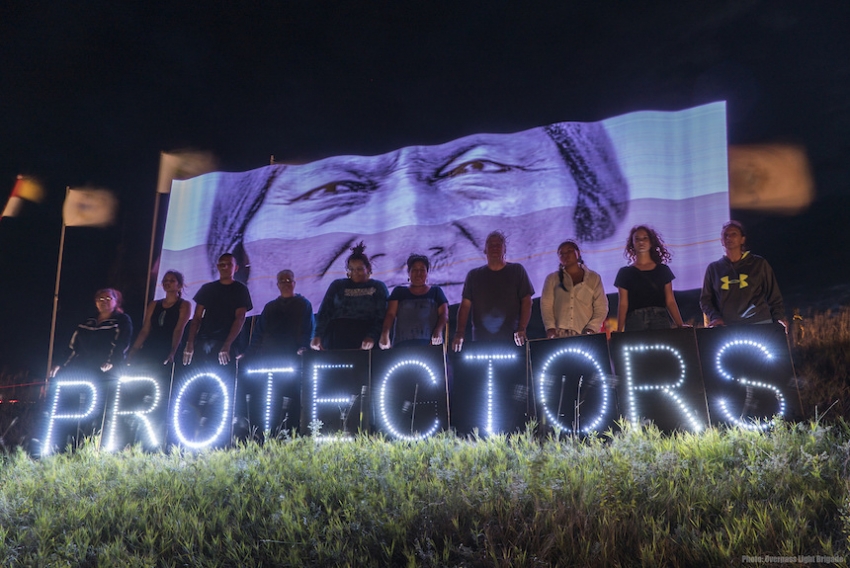
A bigger than life poster of Hunkpapa Lakota chief Sitting Bull is displayed behind protesters of the Dakota Access Pipeline at the Cannonball River encampment: Joe Brusky
By Glynn Wilson –
After protests turned violent in North Dokota with a private company using pepper spray and attack dogs on Native Americans, the Obama administration intervened on Friday and blocked the construction of an oil pipeline on federal land.
The prospect of a $3.7 billion pipeline crossing four states bordering on native lands generated a massive movement of peaceful resistance led by the Standing Rock Sioux.
A joint announcement from the U.S. Department of Justice, the Army Corps of Engineers and the Department of the Interior halting the Dakota Access pipeline came shortly after a federal judge in Washington, D.C. rejected a request from Native Americans for a court order to block the project.
“The Army will not authorize constructing the Dakota Access pipeline on Corps land bordering or under Lake Oahe until it can determine whether it will need to reconsider any of its previous decisions regarding the Lake Oahe site under the National Environmental Policy Act (NEPA) or other federal laws. Therefore, construction of the pipeline on Army Corps land bordering or under Lake Oahe will not go forward at this time,” the administration said in the statement.
“We appreciate the District Court’s opinion on the U.S. Army Corps of Engineers’ compliance with the National Historic Preservation Act. However, important issues raised by the Standing Rock Sioux Tribe and other tribal nations and their members regarding the Dakota Access pipeline specifically, and pipeline-related decision-making generally, remain,” the statement continued.
“Furthermore, this case has highlighted the need for a serious discussion on whether there should be nationwide reform with respect to considering tribes’ views on these types of infrastructure projects. Therefore, this fall, we will invite tribes to formal, government-to-government consultations on two questions: (1) within the existing statutory framework, what should the federal government do to better ensure meaningful tribal input into infrastructure-related reviews and decisions and the protection of tribal lands, resources, and treaty rights; and (2) should new legislation be proposed to Congress to alter that statutory framework and promote those goals.”
Opposition to the pipeline garnered support from 200 Native American tribes, as well as other environmental activists and celebrities. Thousands of people have swelled campgrounds near the site, according to media reports, drawing high-profile protesters like Green Party presidential candidate Jill Stein and actress Shailene Woodley. The protests turned violent last weekend when demonstrators breached a wire fence and were confronted by security officers and guard dogs.
The tribal lands of the Sioux are located about a half-mile south of the proposed pipeline route, and they say the pipeline would desecrate sacred burial and prayer sites as well as potentially leak oil into the Missouri and Cannon Ball rivers, relied on by the tribe for fresh drinking water.
Reacting to the administration’s ruling on Friday, the tribe called the decision “stunning.”
“Our hearts are full, this an historic day for the Standing Rock Sioux Tribe and for tribes across the nation,” tribal chairman Dave Archambault II said in a statement. “Our voices have been heard.”
In North Dakota’s state capital of Bismarck, hundreds of protesters celebrated the decision as a victory.
“We won! We won!” Bobbi Jean Three Legs, a member of the Cheyenne River Sioux of South Dakota, shouted to the cheering crowd, according to Reuters.
The company, Dakota Access, a subsidiary of Energy Transfer Partners LP that was building the pipeline, declined to comment on the decision to halt the project.
In the joint statement halting the pipeline, the administration indicated that tribal leaders would be invited to meetings in the fall to discuss how the federal government could better consider the views of Native Americans and further respect their land.
“We fully support the rights of all Americans to assemble and speak freely,” the government said. “In recent days, we have seen thousands of demonstrators come together peacefully, with support from scores of sovereign tribal governments, to exercise their First Amendment rights and to voice heartfelt concerns about the environment and historic, sacred sites. It is now incumbent on all of us to develop a path forward that serves the broadest public interest.”
The Corps of Engineers, which owns some of the land where the pipeline was to be built and had issued permits in the process, indicated it would halt construction on its property, including land by Lake Oahe, until after officials had re-examined Native American concerns.
The U.S. government also called on Dakota Access to halt work on land nearby, but the company did not say whether it would comply.
If fully connected to existing lines, the 1,100-mile (1,770 km) Dakota Access pipeline would be the first to carry crude oil from the Bakken shale, a vast oil formation in North Dakota, Montana and parts of Canada, directly to the Gulf of Mexico by way of an existing pipeline in Illinois.
Of course even without this pipeline, Bakken shale and Canadian Tar Sands crude is already making it’s way to the Gulf by way of the Canadian National Railroad, which runs right into Mobile, Alabama. The thick, heavy crude is offloaded and stored in huge tank farms, then pumped into pipelines connecting with refineries in Mississippi and into barges and tankers for export abroad.
Local acitivists have not been able to generate the wide spread involvement of national environmental groups to halt this activity, or generate the national publicity of fights like the successful one against the Keystone XL Pipeline out west.













